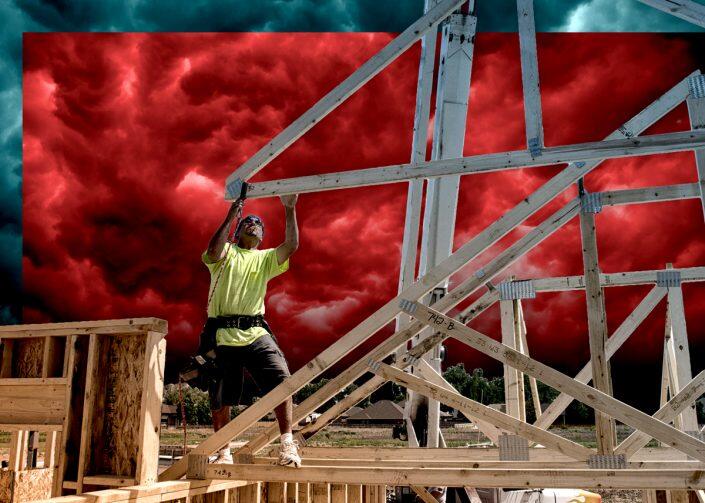 It should be the golden age for homebuilders. The pandemic propelled a mass migration of city dwellers to the suburbs, hungry to buy homes. And that surge in demand has driven new home prices up by 12 percent since March 2020.
It should be the golden age for homebuilders. The pandemic propelled a mass migration of city dwellers to the suburbs, hungry to buy homes. And that surge in demand has driven new home prices up by 12 percent since March 2020.
Great, right? Except construction costs have jumped as much as 30 percent in the same period.
Homebuilding, which depends on careful management of everything from labor to land to lumber to ride out the peaks and valleys of the market, has taken on new levels of complexity. Supply chains have been disrupted by pandemic shutdowns, delaying completions and contributing to rising costs.
Contractors are responding by acquiring building materials and appliances as early as possible. For builders, it’s like the Great Toilet Paper Shortage of 2020, which sent consumers stockpiling and prices soaring, said David Druey, a regional president at Centennial Bank.
“You’ve got people buying stuff because they think they need it,’’ Druey said. “Developers are buying up blocks [of materials] because they know there’s a shortage.”
The list of impediments facing projects large and small is seemingly endless. A semitruck transporting a shipment of toilets that are already delayed goes missing on its way to the local Home Depot after tracking goes offline; contractors lose workers to more convenient and higher paying jobs.
Then there were the winter storms in Texas in February and the six-day blockage of the Suez Canal in March. All these problems raise costs, which developers are mostly forced to shoulder. If they don’t, they risk their contractors going out of business.
Builders have had to jump headfirst into solving supply chain issues, ordering materials weeks or months in advance, finding substitutions and delaying sales of projects to closer to the delivery dates to account for last-minute price fluctuations.
“In this environment, it makes no sense to sell too far out ahead because you lose your ability to offset potential pricing cost increases with sales price increases,” said Rick Beckwitt, co-CEO of Lennar, the biggest U.S. homebuilder, on a recent earnings call.
Homebuilder D.R. Horton has responded by delaying the timing of sales.
“We have slowed our home sales pace to more closely align to our current production levels and are selling homes later in the construction cycle, when we can better ensure the certainty of home close date for our homebuyers,” said president and CEO David Auld.
Median new home prices have jumped to $361,000 since March 2020, according to the U.S. Census Bureau.
 But the surge in demand for new homes is slowing. New home sales reached a 15-year record high in January, and pricing fell in June compared with the previous month.
But the surge in demand for new homes is slowing. New home sales reached a 15-year record high in January, and pricing fell in June compared with the previous month.
Fires and floods
Although builders and analysts expect the cost of materials to also come down, they likely won’t return to pre-pandemic levels. There are still threats to supply chains, many connected to climate change.
In July alone, wildfires in western Canada threatened the U.S. supply of wood just as lumber prices had fallen, while flooding in Germany resulted in the forced closure of a major metal production and recycling plant, the Wall Street Journal reported.
For projects where contractors would normally bear the brunt of higher materials costs, developers are now stepping in.
“We have had to eat some of those increases to ensure we have people to do the work,” said 13th Floor Homes principal Michael Nunziata. “They can’t bear those costs. It would put them out of business.”
Integra Investments began to hit logistical roadblocks this year, including a shortage of appliances due to such missing components, as computer chips, said Nelson Stabile, a principal at the firm.
In one project, the South Florida developer worked around a delayed flooring delivery by installing the baseboards first and going with a local flooring supplier instead of the foreign company it was planning to use.
Projects derailed
In the second quarter, more than 70 percent of contractors reported delays due to the pandemic, according to a report from the U.S. Chamber of Commerce Commercial Construction Index.
Delays are more common than a project being canceled, but that’s also happening sometimes.
Tricon Residential, a Toronto-based investment firm that’s investing heavily in single-family rentals, canceled plans for two projects out of about 20 in the U.S. due to rising costs and supply chain issues, said Andrew Carmody, managing director.
Tricon has held off on ordering lumber whenever possible until prices fall. Rising rents and home prices have helped offset that increase in some markets, but not entirely, Carmody said.
A garage door stuck in the supply chain could hold up the completion of a single-family home. If a builder needs to sell the house in order to move onto other projects, they’ll probably pay a higher price for a door that’s available.
Even securing a construction fence now takes weeks, said luxury spec home developer James Curnin. It used to take him one day.
Curnin said he “can’t get anything” sent to him, including materials and appliances from high-end manufacturers such as Wolf and Sub-Zero. “They can’t even give me their best guesses on when it will come.”
The lumber roller coaster
For more than a year, lumber has been the wild card. The surge in prices for softwood lumber products over the past 15 months added nearly $30,000 to the price of an average new single-family home and $92 a month more in rent for a new apartment, according to a report from the National Association of Home Builders.
Then lumber prices fell. Then came the wildfires.
Prices of lumber have fallen from their highs, but they’re still up nearly 100 percent from the pandemic low more than a year ago. The price of steel, drywall and other materials have also reached record levels this year.
Some contractors are adding price increase contingencies to new contracts to protect themselves from volatile costs, according to Jeff Bartel, who heads an investment and advisory firm that’s involved in projects along the East Coast and in the Sun Belt and California.
“Typically, construction costs in a normal year would rise between 2.5 and 5 percent,” he said.
On top of that, there’s the long-term issue of a dwindling and aging construction workforce.
Labor woes
Even as experts predict that spikes in pricing of materials will eventually subside, labor costs are expected to continue to rise. Competition for workers will become a built-in cost of housing, as higher wages push home prices and rents up.
“We are concerned about the long-term availability of skilled trained labor,” said Carmody of Tricon. “That is very hard work. The popularity of that work is at an all-time low.”
About 88 percent of contractors had moderate to high levels of difficulty finding skilled workers, according to the U.S. Chamber of Commerce report. Forty-five percent said it was highly difficult to find laborers.
Lennar’s co-CEO and co-president Jon Jaffe has said that the labor shortage “persists now more than ever.”
Workers, in high demand, have their pick of construction projects. “If you make it hard for them to work, then you will be less likely to get workers at your project,” said Scott Moss, CEO of Moss Construction.
Nunziata, principal of 13th Floor Homes, said that the cost of labor, materials, regulatory fees and more has “caused our costs to spiral out of control” and that lack of confidence in costs led the company to delay launching some projects.
In addition, the bids that contractors are getting for new business aren’t matching the rising cost of materials.
“We don’t see the pricing reflecting what we’re seeing from suppliers,” Moss said. He predicts that supply chain issues will continue for the next six to eight months.
Lasting effects
Builders are “stuck” with how much they can raise prices to cover the surge in costs, according to Jonathan Miller, president and CEO of Miller Samuel Real Estate Appraisers and author of Douglas Elliman’s market reports.
If and when interest rates rise, sales will slow. Because interest rates have been so low, homebuyers have more purchasing power. The monthly payment is a stronger indicator of affordability than the total price.
“It is the reason housing sales have been sustained despite prices rising so much,” Miller added.
Because of the rising costs, developers have had to go back to their lenders seeking more money, said Peter Dyga, who heads a regional chapter of the industry trade group Associated Builders and Contractors. If they can’t get the financing from their lenders or investors, it can mark the end for a project.
“When you have events like this that have transformed the economy, it will take a while for things to settle,” Dyga said.
Lenders, meanwhile, are trying to value projects based on unreliable and rapidly changing information.
“We’re trying to make sure that when we’re lending money, we’re lending money based on the cost, not the value, and is the cost inflated? Are costs going to stay that high?” said Druey, the Centennial Bank executive. “No one thinks they’re going to stay that high [but] they’re never going back to where they were. That’s just not how things work.”
